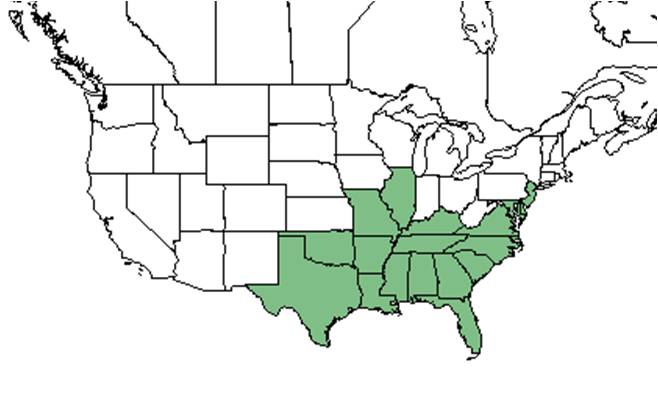Quercus nigra
| Quercus nigra | |
|---|---|

| |
| Photo by Wayne Matchett, SpaceCoastWildflowers.com | |
| Scientific classification | |
| Kingdom: | Plantae |
| Division: | Magnoliophyta - Flowering plants |
| Class: | Magnoliopsida – Dicotyledons |
| Order: | Fagales |
| Family: | Fagaceae |
| Genus: | Quercus |
| Species: | Q. nigra |
| Binomial name | |
| Quercus nigra L. | |

| |
| Natural range of Quercus nigra from USDA NRCS Plants Database. | |
Common name: Water oak
Contents
Taxonomic notes
Synonyms: Q. aquatica Walter
Varieties: Quercus nigra var. heterophylla (Aiton) W.W. Ashe; Q. nigra var. nigra
Description
A description of Quercus nigra is provided in The Flora of North America.
Distribution
Ecology
Habitat
Q. nigra has been found in stream shorelines, hardwood sand ridges, upland woodlands, floodplains, lake shores, river shores, pine-oak woodlands, longleaf pine-wiregrass ridges, cypress swamps, oak ravines, and live oak hammocks.[1] It is also found in disturbed areas including sandhills with mowed lawns, sandy roadsides, campgrounds, nature trails, and along bridges.[1]
Associated species: Nyssa, Ulmus, and Taxodium.[1]
Q. nigra increased its presence in response to soil disturbance by heavy silvilculture in North Carolina longleaf pine sites. It has shown regrowth in reestablished pinelands that were disturbed by these practices.[2]
This species decreased its cover in response to soil disturbance by clearcutting and chopping in north Florida flatwoods forests. It has shown resistance to regrowth in reestablished flatwoods that were disturbed by these practices.[3]
Q. nigra is frequent and abundant in the North Florida Longleaf Woodlands, Xeric Flatwoods, and North Florida Wet Flatlands community types as described in Carr et al. (2010).[4]
Phenology
Q. nigra has been observed flowering in February and March.[5]
Seed dispersal
Q. nigra is thought to be dispersed by gravity. [6]
Fire ecology
Populations of Quercus nigra have been known to persist through repeated annual burns.[7][8][9]
Herbivory and toxicology
Q. nigra has been observed at the Archbold Biological Station to host bees such as Apis mellifera (family Apidae).[10] Additionally, Q. nigra has been observed to host planthoppers such as Catonia sp. (family Achilidae), moths such as Halysidota tessellaris (family Arctiidae), leafhoppers from the Cicadellidae family such as Alebra aurea, Draeculacephala zeae, Eratoneura acantha and Eratoneura parva, true bugs such as Cedusa sp. (family Derbidae) and members of the family Reduviidae such as Triatoma sanguisuga and Zelus luridus, bees from the Membracidae family such as Archasia belfragei, Atymna querci, Cyrtolobus fuliginosus, C. fuscipennis, C. maculifrontis, C. puritanus, C. ovatus, C. tuberosus, Entylia carinata, Ophiderma definita, O. salamandra, Smilia camelus, Spissistilus festinus and Telamona monticola, as well as plant bugs from the Miridae family such as Atractotomus miniatus and Hamatophylus guttulosus.[11]
Conservation, cultivation, and restoration
Cultural use
Photo Gallery
References and notes
- ↑ 1.0 1.1 1.2 Florida State University Herbarium Database. URL: http://herbarium.bio.fsu.edu. Last accessed: June 2021. Collectors: Loran C. Anderson, Robert Doren, Alan R. Franck, Robert K. Godfrey, Bruce Hansen, JoAnn Hansen, H. Kurz, Herbert Monoson, Gwynn W. Ramsey, Ann M. Redmond, W. D. Reese, H. Larry Stripling, and Dwayne Wise. States and counties: Florida: Clay, Columbia, Franklin, Gadsden, Hillsborough, Jackson, Leon, Madison, St. Johns, and Wakulla.
- ↑ Cohen, S., R. Braham, and F. Sanchez. (2004). Seed Bank Viability in Disturbed Longleaf Pine Sites. Restoration Ecology 12(4):503-515.
- ↑ Moore, W.H., B.F. Swindel, and W.S. Terry. (1982). Vegetative Response to Clearcutting and Chopping in a North Florida Flatwoods Forest. Journal of Range Management 35(2):214-218.
- ↑ Carr, S.C., K.M. Robertson, and R.K. Peet. 2010. A vegetation classification of fire-dependent pinelands of Florida. Castanea 75:153-189.
- ↑ Nelson, G. PanFlora: Plant data for the eastern United States with emphasis on the Southeastern Coastal Plains, Florida, and the Florida Panhandle. www.gilnelson.com/PanFlora/ Accessed: 13 DEC 2016
- ↑ Kirkman, L. Katherine. Unpublished database of seed dispersal mode of plants found in Coastal Plain longleaf pine-grasslands of the Jones Ecological Research Center, Georgia.
- ↑ Robertson, K.M. Unpublished data collected from Pebble Hill Fire Plots, Pebble Hill Plantation, Thomasville, Georgia.
- ↑ Glitzenstein, J. S., D. R. Streng, R. E. Masters, K. M. Robertson and S. M. Hermann 2012. Fire-frequency effects on vegetation in north Florida pinelands: Another look at the long-term Stoddard Fire Research Plots at Tall Timbers Research Station. Forest Ecology and Management 264: 197-209.
- ↑ Platt, W.J., R. Carter, G. Nelson, W. Baker, S. Hermann, J. Kane, L. Anderson, M. Smith, K. Robertson. 2021. Unpublished species list of Wade Tract old-growth longleaf pine savanna, Thomasville, Georgia.
- ↑ Deyrup, M.A. and N.D. 2015. Database of observations of Hymenoptera visitations to flowers of plants on Archbold Biological Station, Florida, USA.
- ↑ Discoverlife.org [1]